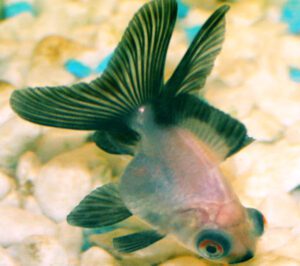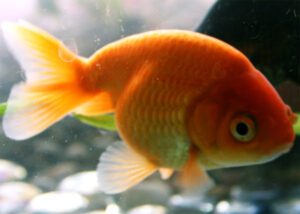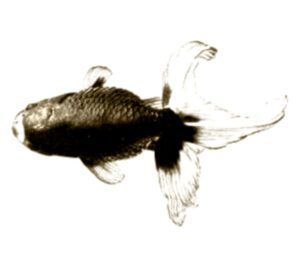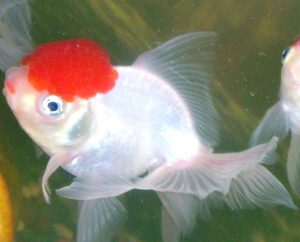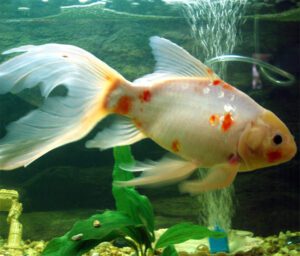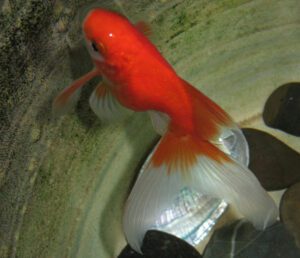The Pompom goldfish is a variety of fancy goldfish which is also known as Pompon, Velvet Ball or Huna Fusa. It has bundles of loose fleshy outgrowths between the nostrils, on each side of the head.
It is actually correctly named the ‘Pompon’, but it is much more commonly known by the name ‘Pompom’ due to it’s appearance.
It was pretty popular in the early days of the fancy goldfish, but is now very rarely seen for sale or on display.
The Pompom goldfish is one of the cute and unique fancy goldfish variety. There is another variants of this species which is called Hana Fusa or White Pompom Oranda, which is an elegant Pompom with a dorsal fin.
It is a pretty old variety, and there are records for the existence of this fish being seen as far back as 1898.
The first importation of these fish into the United Kingdom was in 1936 when the original fish were exported from Shanghai and others were displayed at and aquarium in Paris. Read some more information about this goldfish variety below.
Pompom Goldfish Characteristics
The Pompom goldfish is similar in appearance and body shape to the Oranda and Lionhead Goldfish (but instead of supporting a headgrowth it has nasal outgrowths).
The extent of the nasal outgrowths, which are enlargements of the nasal septum, vary in this fish. The outgrowths hang down past the mouth in some fish.
And these skin outgrowths around the nostrils of Pompoms are developed through selective breeding.
The Pompom goldfish may have either nacreous or metallic scalation, and can occur with or without a dorsal fin.
They have double anal fin and twin tail fins. They are available in many color variations which include blue, white, silver, black, yellow and orange.
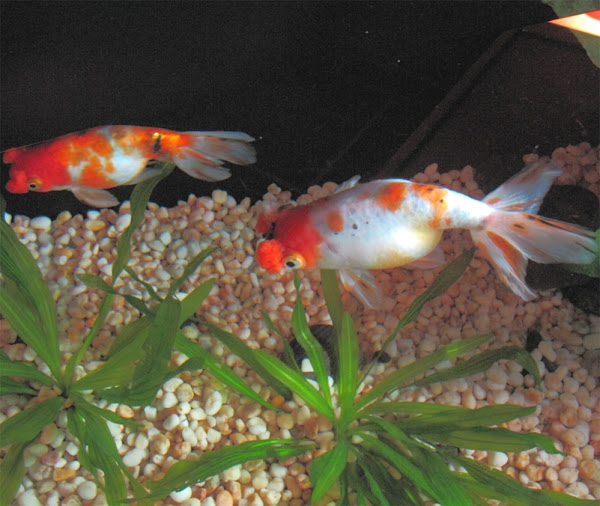
Average body length of the mature Pompom goldfish is between 4 and 6 inches. Photo and info from Wikipedia.
Diet
The Pompom goldfish are omnivorous. They eat almost all types of foods. You can easily feed them with available goldfish foods.
Breeding
The Pompom goldfish is considered to be one of the easiest exotic goldfish varieties to breed. Because they don’t have any features that are apt to make breeding more challenging.
They females generally have a slightly slimmer body shape than the male. And the male fish will gain white tubercles on the edges of their pectoral fins and on the gill plates during the breeding season.
Uses
The Pompom goldfish are ornamental fish. They are entertaining and lovely to watch. They are also good for raising as pets.
Special Notes
The Pompom goldfish is one of the slower swimming goldfish varieties. They are likely to become stressed if housed with the more speedy species.
Favorable temperature of these fish is between 65° and 78°F. Generally they are friendly and social in nature.
It is a pretty long-lived fish with an average lifespan of 10-15 years. But sometimes they can live longer.
However, review full breed profile of the Pompom goldfish in the table below.
| Name | Pompom Goldfish |
| Other Names | Also known as Pompon, Velvet Ball or Huna Fusa |
| Breed Purpose | Ornamental, pet |
| Special Notes | Very beautiful, distinctive look, require moderate care, very social fish and generally thrive in community, friendly and social, one of the slower swimming goldfish varieties, can become stressed if housed with the more speedy species, 10-15 years of average lifespan, favorable temperature of these fish is between 65° and 78°F, raised for ornamental purpose |
| Size | Around 4-6 inches |
| Breeding Method | Artificial |
| Climate Tolerance | Almost all climates |
| Body Color | Common colors are blue, white, silver, black, yellow and orange |
| Rarity | Common |
| Availability | Worldwide |
